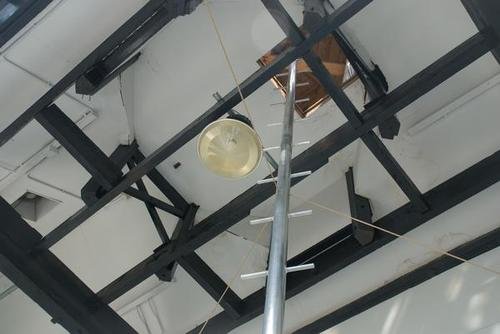10/9/2008
Lee Welch
The Lab, Dublin
Never odd or even and other pieces. The show is an insight into Welch's multi-disciplinary practice exploring architectural intervention, questions of authorship, censorship, appropriation, belief systems, and semiology.

Never Odd or Even and other pieces is an insight into Lee Welch's
multi-disciplinary practice exploring architectural intervention, questions
of authorship, censorship, appropriation, belief systems, and semiology.
Built on cultural iconography he provides a glimpse of alternative ways of
approaching and thinking about art. His conceptual framework engages with
archival material through texts and appropriated images that have become
part of a lexicon of cultural reference.
The collaboration with Ken Meehan and Jeanette Doyle has led to an
architectural intervention within the exhibition space. Transforming it, to
capture spatial metaphors, transporting the viewer to an alternate space
where they view the work. The stark white structures provide a space where a
singular piece can exist in isolation. This intervention of sculptural
architecture is indicative of minimalists concern with real space and
ridding themselves of the problem of illusion and literal space. Welch's
spatial experimentation leads to questions of how spaces are used and how
they provide a framework for viewing art. How does the white cube as a space
benefit the artwork?
In his video piece Divination he explores the ritual of water witching or
divining as it is commonly known. This age old ritual is steeped in a system
of belief where this inanimate object the 'dowsing rod' becomes a primary
agent in this interaction, or conversation between the diviner and nature.
The diviner explains the process of transformation where the diviner and the
rod, the life force become one. He describes it as a meditative process
where one gives oneself up to a belief. It is the beauty of the
unexplained, the illusion. Freud in his book 'The Future of an Illusion'
equates belief and illusion with desire. 'We refer to belief as an illusion
when wish fulfillment plays a prominent part in its motivation, and in the
process we disregard its relationship to reality, just as the illusion
itself dispenses with accreditations'. The Rod a sculpture comprising of a
divining rod cast in bronze immortalizes the object of divination.
Welch explores ideas of the sublime in his video piece Lady Chatterly. He
takes as his starting point a film adaptation of D.H Lawrence's 1928 novel
Lady Chatterley's Lover. This piece is a montage of scenes of Lady Chatterly
in nature; the experience of the sublime in this film work involves a
self-forgetfulness where Lady Chatterly's personal fear is replaced by a
sense of well-being and security when confronted with the superiority of
nature.
'Between the essence and the descent, falls the shadow' is a sculptural
piece that can be viewed from alternative perspectives in the gallery. Its
structure and form are a reflection of 'A suspicious affinity' the image of
Adams Carter who is documented trying to re-create the photograph Dr Cook
used as proof of his achievement of reaching the summit of Mount Mckinley in
1906. Cook's claim had being questioned by fellow explorers. Cook's story
has become part of a historical mythology surrounding this period of heroic
exploration. Barthes 'Mythologies' states that 'myth hides nothing and
flaunts nothing: it distorts; myth is neither a lie nor a confession; it is
an inflexion.' It is open to interpretation it embodies the parameters of
potentiality.
The image of Hitchcock titled 'The suspense of disbelief' pictures him
sitting next to an Indian rope. Hitchcock embodies notions of visual
trickery, mythology and his overt use of signs and symbols throughout his
films that may or may not have meaning continues this exploration of
cultural iconology that is prevalent throughout the exhibition.
Lee Welch's work leaves the viewer searching for the elusive truth, there
are points of crystallization throughout the exhibition but at points you
are left questioning. The works can be appreciated on straightforward level,
but for the viewer who is willing to delve deeper the pieces take on much
more cultural significance. In a society where images have become the means
of communication, Welch successfully takes these images and transforms them
into subtle explorations that are open for interpretation.
Image: Between the essence and the descent falls the shadow, 2008, Aluminum
Opens:Thursday September 11th 6-8pm
The Lab
Foley Street - Dublin
Free admission



